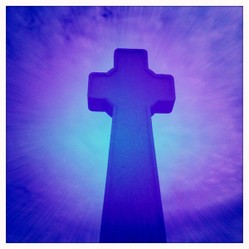The second sign that something uncanny was occurring was the sound of a musket shot. The lady puzzled over it, scrambling onto a boulder outcrop to identify the source. From here, she had a good view of the pass beneath her. She saw nobody firing old weapons.
The disturbance came, not from below, but right up here with her. The woman heard footfalls on gravel and turned around. There was no gravel on this road. It was tarmacked completely, yet it was gravel she heard.
A large, frightened Highlander was hurtling towards her. She could see every detail, though she knew the man was not entirely real. The ashen face, with its horrific expression, appeared to glow, as if moonbeams were upon it.
Yet it was two in the afternoon, on a bright, glorious day.
The woman closed her eyes, sure that she was hallucinating. But she could still hear those running feet on gravel. She opened them again. The Highlander had not gone away. It reached the cyclist and sped right past her, close enough to touch, had the cyclist dared. But the Highlander never acknowledged her, nor even seemed to see her.
Down in the pass came a second musket shot. The sound of it echoed from crags and the valley walls. In the instant that it took the woman to swing around, reacting to the gunfire, the Highlander had gone.
Before her horrified vision, she saw the red coat army marching down in the bottom of the Killiecrankie Pass. Thousands of them marching, several abreast, around an outcrop and out of view.
By now thoroughly spooked, the tourist decided it was time to go. She grabbed her bicycle and made to mount it. But her foot touched against something seemingly solid.
She looked down. It was a red coat soldier moaning through a fatal wound. Nor was he alone. Suddenly the entire Pass seemed full of them. Bodies strewn amidst the greenery. The Williamites vivid in scarlet. The Highlanders clad in plaid. All of them dying, screaming to her in their agony.
Rooted to the ground with shock, the woman could only watch. Then she saw the girl.
Like so many before and since, she saw the girl. And of all the horrors that she'd witnessed that day, this was the worst of all.




 Many battlefields have phenomena associated with the anniversary date. Killiecrankie battle site is no exception.
Many battlefields have phenomena associated with the anniversary date. Killiecrankie battle site is no exception.







 The B8079 runs straight through the Killiecrankie Pass, leaving the A9 just three miles north of Pitlochry to do so.
The B8079 runs straight through the Killiecrankie Pass, leaving the A9 just three miles north of Pitlochry to do so.











 St Tydecho's Churches in West Waleson 09/03/2014
St Tydecho's Churches in West Waleson 09/03/2014
 Goodies for an Outlander Premiere Partyon 03/06/2015
Goodies for an Outlander Premiere Partyon 03/06/2015
 Holocaust Memorial Day Interview with Rainer Höss, Grandson of Rudolf Architect of Auschwitzon 01/24/2015
Holocaust Memorial Day Interview with Rainer Höss, Grandson of Rudolf Architect of Auschwitzon 01/24/2015
 Romantic Valentine Gifts for an Outlander Fanon 01/16/2015
Romantic Valentine Gifts for an Outlander Fanon 01/16/2015



Comments
Ah! That would explain it. I'm still noting the rich variety of whisky in memory. :)
I did note the rich variety fo whisky, but I do not drink whisky very often.
Same! Red Squirrel Campsite was so gorgeous! We got it out of the Cool Camping Scotland book. Did you check out the massive variety of whisky in the pub down the bottom of the slope? I most certainly did!
It was the hospitality angle which really made me shudder, when I first heard about it. You just don't do something like that. I mean in general terms, but definitely not when you've been offered a cup of tea!
I stayed at Red Squirrel campsite, which is a pleasant little place by the river.
What strikes me, though, is that by highland standards the massacre of Glencoe was nothing out of the ordinary.It was the treachery that made it unacceptable. Clans attempting slaughter on other clans was common enough, but they were not supposed to accept hospitality before murdering their hosts. Much violence in Scotland was done by Scot on Scot, so there must be plenty of sites in Scotland where violence has been done.
Shonna - Ooh! Would she be willing to talk about it now? If you asked her, now that you're older?
Frank - I was just a mile or so away, down the river, from the village. I walked up there to stand at the memorial, then wandered around to the loch and back. It was incredibly beautiful but, like you, I felt nothing actually preternatural.
Huh...my mother isn't particularly sensitive which is why I was curious - something there creeped her out but I don't know what, she won't talk about it. I wonder if she was there on the day or something...it's one of the rare times she brought it up to me.
I also camped twice in Glencoe, and I did not feel or see anything ghostly, but we camped up the valley, some distance from the massacre site.
I actually camped in Glencoe! It's a beautiful place, but nothing of particularly ghostly behavior left, despite the massacre. Glencoe's biggest psychic error was blind-siding me when it came to visiting Culloden shortly afterwards. -.-
Really good one! Have you been to Glencoe yet? My mother was affected by that place - don't know that she's ever been to Killiecrankie - can't think of why she wouldn't, she's travelled all over the place there. She just said that Glencoe was the most haunted place she'd been to besides Culloden. I immediately thought of you LOL
X